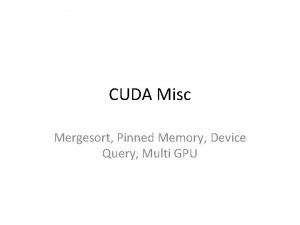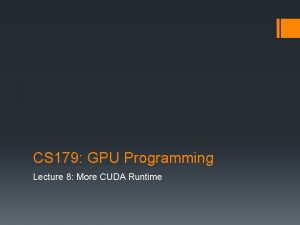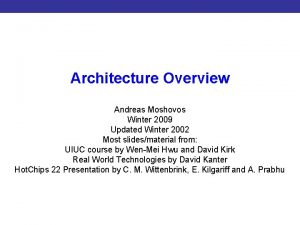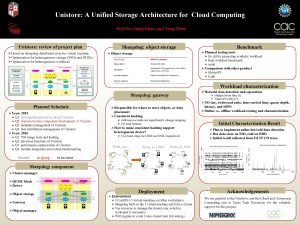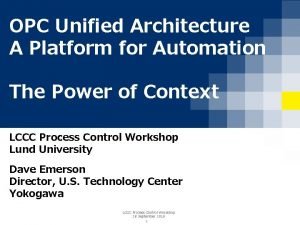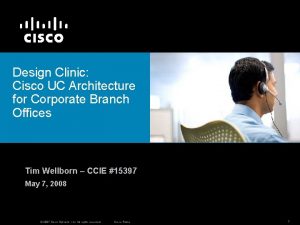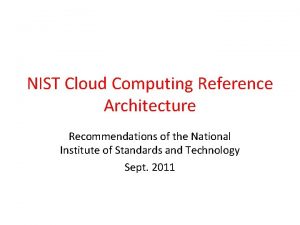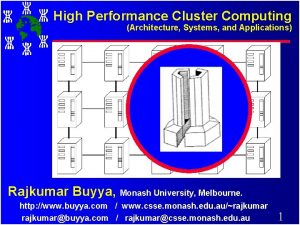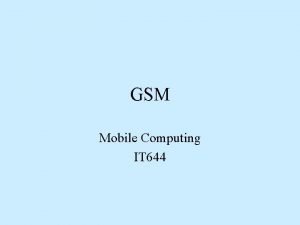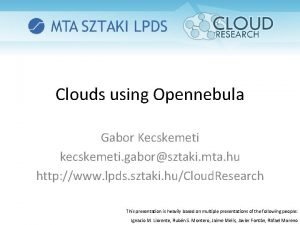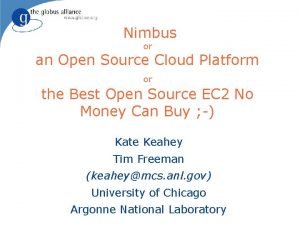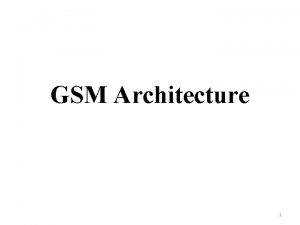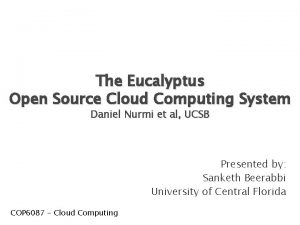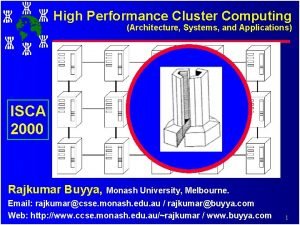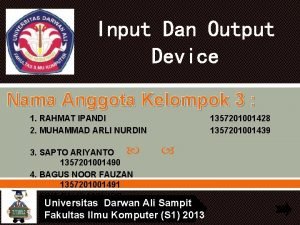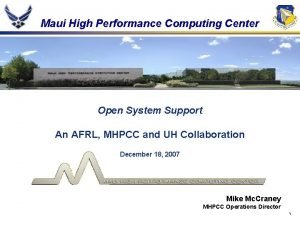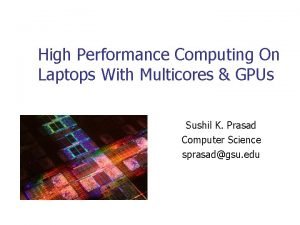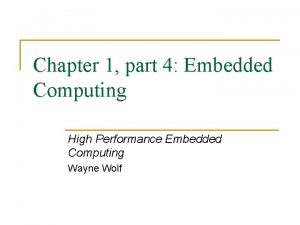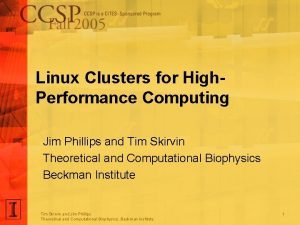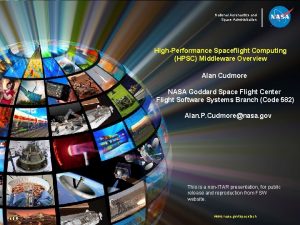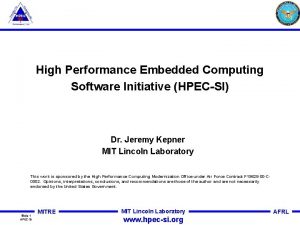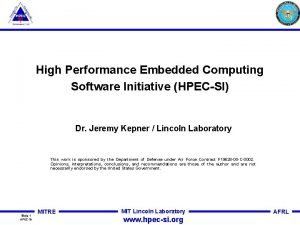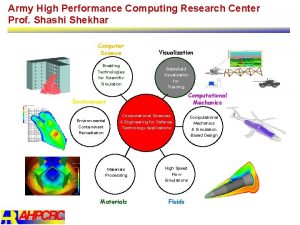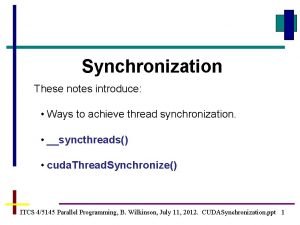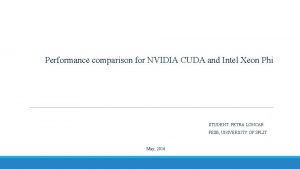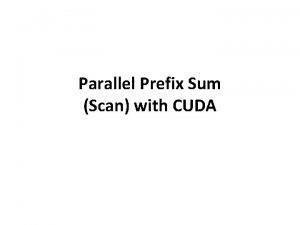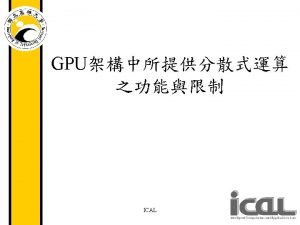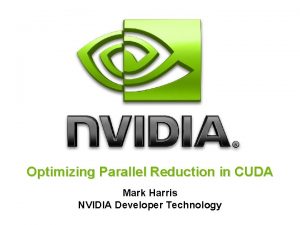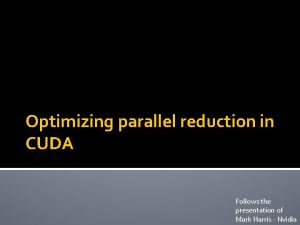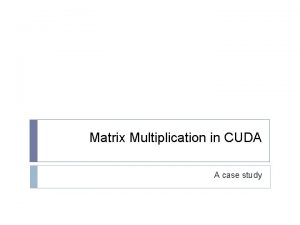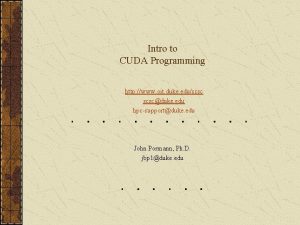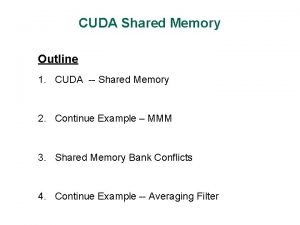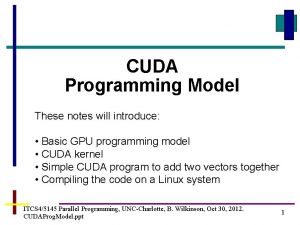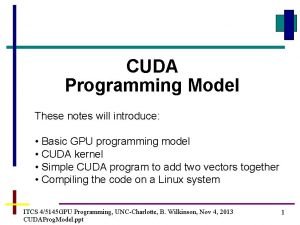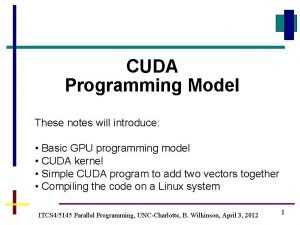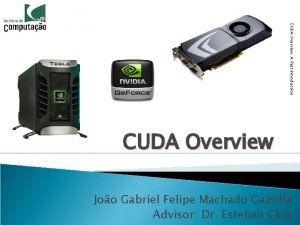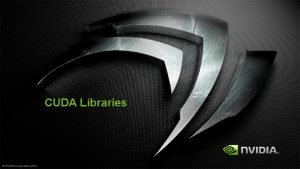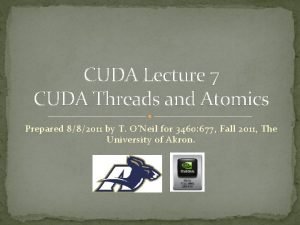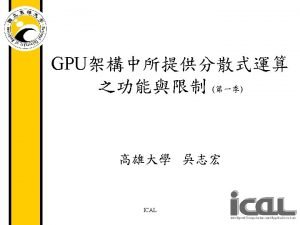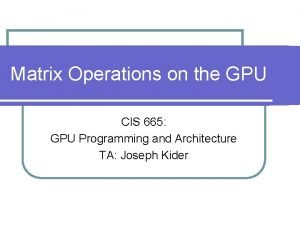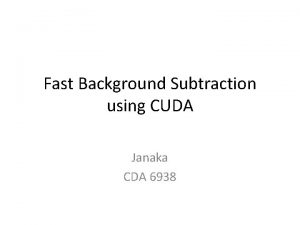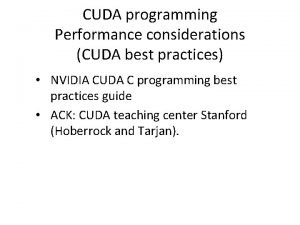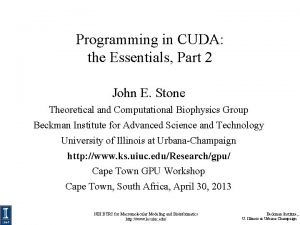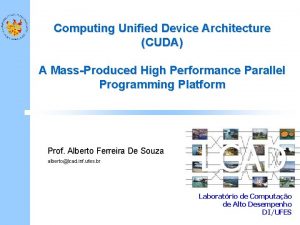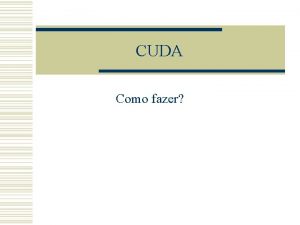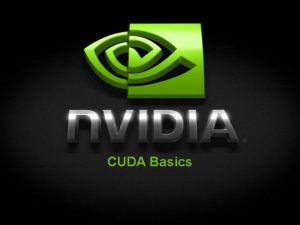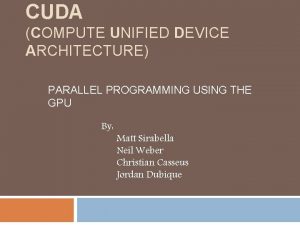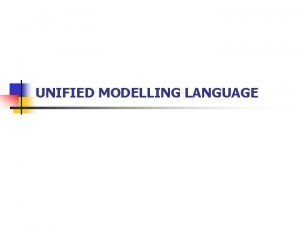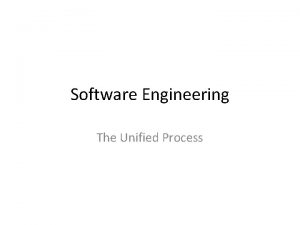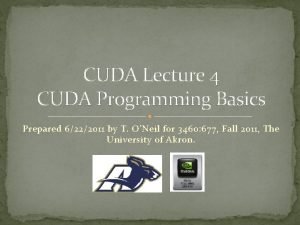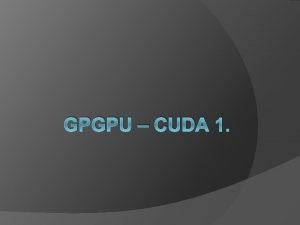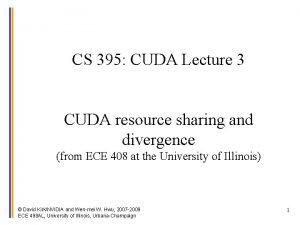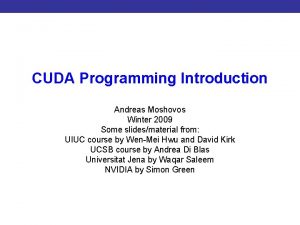Computing Unified Device Architecture CUDA A MassProduced High





































































- Slides: 69

Computing Unified Device Architecture (CUDA) A Mass-Produced High Performance Parallel Programming Platform Prof. Alberto Ferreira De Souza alberto@lcad. inf. ufes. br LCAD Laboratório de Computação de Alto Desempenho DI/UFES

Overview • The Compute Unified Device Architecture (CUDA) is a new parallel programming model that allows general purpose high performance parallel programming through a small extension of the C programming language LCAD

LCAD Overview The 8800 has 128 processors Ge. Force 8800 block diagram

Overview • The Single Instruction Multiple Thread (SIMT) architecture of CUDA enabled GPUs allows the implementation of scalable massively multithreaded general purpose code LCAD

Overview LCAD • Currently, CUDA GPUs possess arrays of hundreds of processors and peak performance approaching 1 Tflop/s

Overview LCAD • Where all this performance comes from? – More transistors are devoted to data processing rather than data caching and ILP exploitation support • The computer gamming industry provides economies of scale • Competition fuels innovation

Overview LCAD • More than 100 million CUDA enabled GPUs have already been sold • This makes it the most successful high performance parallel computing platform in computing history and, perhaps, one of the most disruptive computing technologies of this decade • Many relevant programs have been ported to C+CUDA and run orders of magnitude faster in CUDA enabled GPUs than in multi-core CPUs

Overview LCAD http: //www. nvidia. com/object/cuda_home. html

Overview LCAD http: //www. nvidia. com/object/cuda_home. html

Overview LCAD http: //www. nvidia. com/object/cuda_home. html

Overview LCAD • In this tutorial we will: – Discuss the scientific, technological and market forces that led to the emergence of CUDA – Examine the architecture of CUDA GPUs – Show to program and execute parallel C+CUDA code

Forces that Led to the Emergence of CUDA LCAD • Scientific advances and innovations in hardware and software have enabled exponential increase in the performance of computer systems over the past 40 years J. L. Hennessy, D. A. Patterson, “Computer Architecture: A Quantitative Approach, Fourth Edition”, Morgan Kaufmann Publishers, Inc. , 2006.

Forces that Led to the Emergence of CUDA • Moore's law allowed manufacturers to increase processors’ clock frequency by about 1, 000 times in the past 25 years • But the ability of dissipating the heat generated by these processors reached physical limits • Significant increase in the clock frequency is now impossible without huge efforts in the cooling of ICs • This problem is known as the Power Wall and has prevented the increase in the performance of single-processor systems LCAD Front: Pentium Overdrive (1993) completed with its cooler Back: Pentium 4 (2005) cooler.

Forces that Led to the Emergence of CUDA LCAD • For decades the performance of the memory hierarchy has grown less than the performance of processors • Today, the latency of memory access is hundreds of times larger than the cycle time of processors J. L. Hennessy, D. A. Patterson, “Computer Architecture: A Quantitative Approach, Third Edition”, Morgan Kaufmann Publishers, Inc. , 2003.

Forces that Led to the Emergence of CUDA LCAD • With more processors on a single IC, the need for memory bandwidth is growing larger • But the number of pins of ICs is limited… • This latency + bandwidth problem is known as the Memory Wall The Athlon 64 FX-70, launched in 2006, has two processing cores that can run only one thread at a time, while the Ultra. SPARC T 1, launched in 2005, has 8 cores that can run 4 threads simultaneously each (32 threads in total). The Athlon 64 FX-70 has 1207 pins, while the Ultra. SPARC T 1, 1933 pins

Forces that Led to the Emergence of CUDA LCAD • Processor architectures capable of executing multiple instructions in parallel, out of order and speculatively also contributed significantly to the increase in processors’ performance • However, employing more transistors in the processors’ implementation has not resulted in greater exploitation of ILP • This problem is known as the ILP Wall

Forces that Led to the Emergence of CUDA LCAD • David Patterson summarized: – the Power Wall + The Memory Wall + ILP the Wall = the Brick Wall for serial performance • All evidences points to the continued validity of Moore's Law (at least for the next 13 years, according with ITRS 06) • However, without visible progress in overcoming the obstacles, the only alternative left to the industry was to implement an increasing number of processors on a single IC

Forces that Led to the Emergence of CUDA LCAD • The computer industry changed its course in 2005, when Intel, following the example of IBM (POWER 4) and Sun (Niagara), announced it would develop multi-core x 86 systems • Multi-core processors take advantage of the available number of transistors to exploit large grain parallelism • However, systems with multiple processors are among us since the 1960 s, but efficient mechanisms for taking advantage large and fine grain parallelism of applications until recently did not exist • In this context appears CUDA

Forces that Led to the Emergence of CUDA LCAD • Fuelled by demand in the gaming industry, GPUs’ performance increased strongly • Also, the larger number of transistors available allowed advances in GPUs’ architecture, which lead to Tesla, which supports CUDA NVIDIA, “NVIDIA CUDA Programming Guide 2. 0”, NVIDIA, 2008.

Forces that Led to the Emergence of CUDA LCAD • Where the name “Compute Unified Device Architecture (CUDA)” comes from? – Traditional graphics pipelines consist of separate programmable stages: • Vertex processors, which execute vertex shader programs • And pixel fragment processors, which execute pixel shader programs – CUDA enabled GPUs unify the vertex and pixel processors and extend them, enabling highperformance parallel computing applications written in the C+CUDA

Forces that Led to the Emergence of CUDA LCAD • A GPU performs image synthesis in three steps 1. Processes triangles’ vertices, computing screen positions and attributes such as color and surface orientation 2. Sample each triangle to identify fully and partially covered pixels, called fragments 3. Processes the fragments using texture sampling, color calculation, visibility, and blending • Previous GPUs specific hardware for each one Ge. Force 6800 block diagram

Forces that Led to the Emergence of CUDA • • Pixel-fragment processors traditionally outnumber vertex processors However, workloads are not well balanced, leading to inefficiency Unification enables dynamic load balancing of varying vertex- and pixelprocessing workloads and permit easy introduction of new capabilities by software The generality required of a unified processor allowed the addition of the new GPU parallelcomputing capability LCAD Ge. Force 6800 block diagram

Forces that Led to the Emergence of CUDA LCAD • GPGPU general-purpose computing by casting problems as graphics rendering – Turn data into images (“texture maps”) – Turn algorithms into image synthesis (“rendering passes”) • C+CUDA true parallel programming – Hardware: fully general data-parallel architecture – Software: C with minimal yet powerful extensions

The Tesla Architecture Ge. Force 8800 block diagram LCAD

The Tesla Architecture • LCAD The Ge. Force 8800 GPU scalable Streaming Processor array (SPA): – Has 8 independent processing units called Texture/Processor Clusters (TPC) – Each TPC has 2 Streaming Multiprocessors (SM) – Each SM has 8 Streaming -Processor (SP) cores (128 total) • The SPA performs all the GPU’s programmable calculations – Its scalable memory system includes a L 2 and external DRAM – An interconnection network carries data from/to SPA to/from L 2 and external DRAM Ge. Force 8800 block diagram

The Tesla Architecture • • • LCAD Some GPU blocks are dedicated to graphics processing The Compute Work Distribution (CWD) block dispatches Blocks of Threads to the SPA The SPA provides Thread control and management, and processes work from multiple logical streams simultaneously The number of TPCs determines a GPU’s programmable processing performance It scales from one TPC in a small GPU to eight or more TPCs in high performance GPUs Ge. Force 8800 block diagram

The Tesla Architecture • Each TPC contains: • The SMC unit implements external memory load/store, and atomic accesses The SMC controls the SMs, and arbitrates the load/store path and the I/O path • LCAD – 1 Geometry Controller – 1 Streaming Multiprocessors Controller (SMC) – 2 Streaming Multiprocessors (SM), – 1 Texture Unit Texture/Processor Clusters (TPC)

The Tesla Architecture • • LCAD Each TPC has two Streaming Multiprocessors (SM) Each SM consists of: – 8 Streaming Processor (SP) cores – 2 Special Function Units (SFU) – 1 Instruction Cache (I cache) – 1 read-only Constant Cache (C cache) – 1 16 -Kbyte read/write Shared Memory – 1 Multithreaded Instruction Fetch and Issue Unit (MT Issue) Streaming Multiprocessors (SM)

The Tesla Architecture • LCAD The Streaming Processor (SP) cores and the Special Function Units (SFU) have a register-based instruction set and executes float, int, and transcendental operations (SFU): – add, multiplyadd, minimum, maximum, compare, set predicate, and conversions between int and FP numbers – shift left, shift right, and logic operations – branch, call, return, trap, and barrier synchronization – cosine, binary exp. , binary log. , reciprocal, and reciprocal square root Streaming Multiprocessors (SM)

The Tesla Architecture • LCAD The Streaming Multiprocessor SP cores and SFUs can access three memory spaces: – Registers – Shared memory for lowlatency access to data shared by cooperating Threads in a Block – Local and Global memory for per-Thread private, or all-Threads shared data (implemented in external DRAM, not cached) – Constant and Texture memory for constant data and textures shared by all Threads (implemented in external DRAM, cached) Streaming Multiprocessors (SM)

The Tesla Architecture • LCAD The SM’s MT Issue block issues SIMT Warp instructions – A Warp consists of 32 Threads of the same type • • The SM schedules and executes multiple Warps of multiple types concurrently The MT Issue Scheduler operates at half clock rate – At each issue cycle, it selects one of 24 Warps (each SM can manage 24 x 32=768 Threads) – An issued Warp executes as 2 sets of 16 Threads over 4 cycles – SP cores and SFU units execute instructions independently; the Scheduler can keep both fully occupied Streaming Multiprocessors (SM)

LCAD The Tesla Architecture • • Since a Warp takes 4 cycles to execute, and the Scheduler can issue a Warp every 2 cycles, the Scheduler has spare time to operate SM hardware implements zero-overhead Warp scheduling – Warps whose next instruction has its operands ready are eligible for execution – Eligible Warps are selected for execution on a prioritized scheduling policy All Threads in a Warp execute the same instruction when selected – But all Threads of a Warp are independent… SM multithreaded Warp scheduler time warp 8 instruction 11 warp 1 instruction 42 warp 3 instruction 95. . . warp 8 instruction 12 warp 3 instruction 96

LCAD The Tesla Architecture • • • SM achieves full efficiency when all 32 Threads of a Warp follow the same path If Threads of a Warp diverge due to conditional branches: – The Warp serially executes each branch path taken – Threads that are not on the path are disabled – When all paths complete, the Threads reconverge The SM uses a branch synchronization stack to manage independent Threads that diverge and converge Branch divergence only occurs within a Warp – Warps execute independently, whether they are executing common or disjoint code paths A Scoreboard gives support all that SM multithreaded Warp scheduler time warp 8 instruction 11 warp 1 instruction 42 warp 3 instruction 95. . . warp 8 instruction 12 warp 3 instruction 96

LCAD The Tesla Architecture • Going back to the top C+CUDA parallel program – Has serial parts that execute on CPU – And Parallel CUDA Kernels that execute on GPU (Grids of Blocks of Threads) CPU Serial Code Grid: 1 D, 2 D, or 3 D group of Blocks GPU Parallel Kernel. A<<< n. Blk, n. Thr >>>(args); Block: 1 D, 2 D, or 3 D group of Threads Grid 0. . . CPU Serial Code GPU Parallel Kernel. B<<< n. Blk, n. Thr >>>(args); Grid 1. . .

LCAD The Tesla Architecture • A Kernel is executed as a Grid of Blocks • A Block is a group of Threads that can cooperate with each other by: – Efficiently sharing data through the low latency shared memory – Synchronizing their execution for hazardfree shared memory accesses • Two Threads from two different Blocks cannot directly cooperate Host Device Grid 1 Kernel 1 Block (0, 0) Block (1, 0) Block (2, 0) Block (0, 1) Block (1, 1) Block (2, 1) Grid 2 Kernel 2 Block (1, 1) Thread Thread (0, 0) (1, 0) (2, 0) (3, 0) (4, 0) Thread Thread (0, 1) (1, 1) (2, 1) (3, 1) (4, 1) Thread Thread (0, 2) (1, 2) (2, 2) (3, 2) (4, 2)

The Tesla Architecture • The programmer declares Blocks: – of 1, 2, or 3 dimensions – containing 1 to 512 Threads in total • • LCAD All Threads in a Block execute the same Thread Program Each threads have a Thread Id within a Block Threads share data and synchronize while doing their share of the work The Thread Program uses the Thread Id to select work and to address shared data CUDA Thread Block Thread Id #: 0123… m Thread Program

The Tesla Architecture LCAD Based on Kernel calls, enumerate the Blocks of the Grids and distribute them to the SMs of the SPA Calls GPU’s Kernels Ge. Force 8800 block diagram

The Tesla Architecture LCAD • Blocks are serially distributed to all SMs – Typically more than 1 Block per SM • Each SM launches Warps of Threads – 2 levels of parallelism • The SMs schedule and execute Warps that are ready to run • As Warps and Blocks complete, resources are freed – So, the SPA can distribute more Blocks Ge. Force 8800 block diagram

The Tesla Architecture • LCAD The Ge. Force 8800 in numbers: – 8 Texture/Processor Clusters (TPC) – 16 Streaming Multiprocessors (SM) – 128 Streaming. Processor (SP) cores – Each SM can handle 8 Blocks simultaneously – Each SM can schedule 24 Warps simultaneously – Each Warp can have up to 32 active Threads – So, each SM can manage 24 x 32=768 simultaneous Threads – The Ge. Force can execute 768 x 16=12, 288 Threads concurrently! Ge. Force 8800 block diagram

LCAD The Tesla Architecture • Intel Core 2 Extreme QX 9650 versus NVIDIA Ge. Force GTX 280 Intel Core 2 Extreme QX 9650 NVIDIA Ge. Force GTX 280 Peak Gflop/s 96 Gflop/s 933 Gflop/s ~ 10 x Transistors 820 million 1. 4 billion ~ 2 x Processor clock 3 GHz Cores 4 Cache / Shared Memory 6 MB x 2 (12 MB) 16 KB x 30 (0, 48 MB) ~ 1/25 Threads executed per clock 4 240 ~ 60 x Hardware threads in flight 4 30, 720 ~ 8, 000! Memory Bandwidth 12. 8 GBps To compensate for that Use this 1. 296 GHz ~ 1/2 240 ~ 60 x 141. 7 GBps ~ 11 x

The Tesla Architecture • Memory Hierarchy (hardware) – Registers: dedicated HW single cycle – Shared Memory: dedicated HW single cycle – Constant Cache: dedicated HW single cycle – Texture Cache: dedicated HW single cycle – Device Memory – DRAM, 100 s of cycles LCAD

The Tesla Architecture • Each Ge. Force 8800 SM has 8192 32 -bit registers – This is an implementation decision, not part of CUDA – Registers are dynamically partitioned across all Blocks assigned to the SM – Once assigned to a Block, the register is NOT accessible by Threads in other Blocks – Each Thread in the same Block only accesses registers assigned to itself LCAD

The Tesla Architecture LCAD • The number of registers constrains applications • For example, if each Block has 16 X 16 Threads and each Thread uses 10 registers, how many Blocks can run on each SM? – Each Block requires 10*256 = 2560 registers – 8192 > 2560 * 3 – So, three Blocks can run on an SM as far as registers are concerned • How about if each Thread increases the use of registers by 1? – Each Block now requires 11*256 = 2816 registers – 8192 < 2816 * 3 – Now only two Blocks can run on an SM

The Tesla Architecture • Each Ge. Force 8800 SM has 16 KB of Shared Memory – Divided in 16 banks of 32 bit words • CUDA uses Shared Memory as shared storage visible to all Threads in a Block – Read and write access • • • Each bank has a bandwidth of 32 bits per clock cycle Successive 32 -bit words are assigned to successive banks Multiple simultaneous accesses to a bank result in a bank conflict – Conflicting accesses are serialized LCAD

LCAD The Tesla Architecture • Linear addressing stride == 1 – No Bank Conflicts • Random 1: 1 Permutation – No Bank Conflicts Thread 0 Thread 1 Thread 2 Thread 3 Thread 4 Thread 5 Thread 6 Thread 7 Bank 0 Bank 1 Bank 2 Bank 3 Bank 4 Bank 5 Bank 6 Bank 7 Thread 15 Bank 15

Bank Addressing Examples • Linear addressing stride == 2 – 2 -way Bank Conflicts Thread 0 Thread 1 Thread 2 Thread 3 Thread 4 Thread 8 Thread 9 Thread 10 Thread 11 • LCAD Linear addressing stride == 8 – 8 -way Bank Conflicts Bank 0 Bank 1 Bank 2 Bank 3 Bank 4 Bank 5 Bank 6 Bank 7 Thread 0 Thread 1 Thread 2 Thread 3 Thread 4 Thread 5 Thread 6 Thread 7 Bank 15 Thread 15 x 8 Bank 0 Bank 1 Bank 2 Bank 7 Bank 8 Bank 9 Bank 15

The Tesla Architecture • Each Ge. Force 8800 SM has 64 KB of Constant Cache • Constants are stored in DRAM and cached on chip • A constant value can be broadcast to all threads in a Warp – Extremely efficient way of accessing a value that is common for all threads in a Block – Accesses in a Block to different addresses are serialized LCAD

The Tesla Architecture • The Ge. Force 8800 SMs have also a Texture Cache • Textures are stored in DRAM and cached on chip • Special hardware speeds up reads from the texture memory space – This hardware implements the various addressing modes and data filtering suitable to this graphics data type LCAD

The Tesla Architecture LCAD • The Ge. Force 8800 has 6 64 -bit memory ports – 86. 4 GB/s bandwidth – But this limits code that does a single operation in DRAM data to 21. 6 GFlop/s • To get closer to the peak 346. 5 GFlop/s you have to access data more then once and take advantage of the memory hierarchy – L 2, Texture Cache, Constant Cache, Shared Memory, and Registers Ge. Force 8800 block diagram

LCAD The Tesla Architecture • The host accesses the device memory via PCI Express bus • The bandwidth of PCI Express is ~8 GB/s (~2 GWord/s) • So, if go through your data only once, you actually can have only ~2 Gflop/s… Host Grid Block (0, 0) Block (1, 0) Shared Memory Registers Thread (0, 0) Thread (1, 0) Local Memory Global Memory Constant Memory Texture Memory Local Memory

LCAD The Tesla Architecture • M. H. (Software) Each Thread can: • 1. Read/write per-Thread Registers 2. Read/write per-Thread Local Memory (not cached) 3. Read/write per-Block Shared Memory 4. Read/write per-Grid Global Memory (not cached) 5. Read only per-Grid Constant Memory (cached) 6. Read only per-Grid Texture Memory (cached) The host can read/write Global, Constant, and Texture memory Grid Block (0, 0) Block (1, 0) Shared Memory Registers Host Registers Shared Memory Registers Thread (0, 0) Thread (1, 0) Local Memory Global Memory Constant Memory Texture Memory Local Memory

LCAD The Tesla Architecture Thread • Local Memory: – • Shared Memory • Private per Thread Shared Memory: per-Block – – Block per-Thread Shared by Threads of the same Block Inter-Thread communication Global Memory: per-Application – – Shared by all Threads Inter-Grid communication Grid 0. . . Grid 1. . . Global Memory (Global, Constant, and Texture) Sequential Grids in Time

LCAD Parallel Programming in C+CUDA • How to start? – Install your CUDA enabled board – Install the CUDA Toolkit – Install the CUDA SDK – Change some environment variables • The SDK comes with several examples Ge. Force 8800

Parallel Programming in C+CUDA LCAD Function Type Qualifiers __device__ • The __device__ qualifier declares a function that is: – Executed on the device – Callable from the device only __global__ • __global__ qualifier declares a function as being a kernel. Such a function is: – Executed on the device, – Callable from the host only

Overview • Function Type Qualifiers are added before functions • The __global__ functions are always called with a configuration • The __device__ functions are called by __global__ functions LCAD

Parallel Programming in C+CUDA LCAD Restrictions • __device__ and __global__ functions do not support recursion • __device__ and __global__ functions cannot declare static variables inside their body • __device__ and __global__ functions cannot have a variable number of arguments • __device__ functions cannot have their address taken • __global__ functions must have void return type • A call to a __global__ function is asynchronous • __global__ function parameters are currently passed via shared memory to the device and are limited to 256 bytes

Parallel Programming in C+CUDA LCAD Variable Type Qualifiers __device__ • Declares a variable that resides on the device – Resides in global memory space – Has the lifetime of an application – Is accessible from all the threads within the grid and from the host

Parallel Programming in C+CUDA LCAD __constant__ • Declares a variable that – Resides in constant memory space – Has the lifetime of an application – Is accessible from all the threads within the grid and from the host __shared__ • Declares a variable that – Resides in shared memory space of a Block – Has the lifetime of a Block – Is only accessible from all threads within a Block

Parallel Programming in C+CUDA LCAD Restrictions • These qualifiers are not allowed on struct and union members, or on function parameters • __shared__ and __constant__ variables have implied static storage • __device__, __shared__ and __constant__ variables cannot be defined as external using the extern keyword • __constant__ variables cannot be assigned to from the device, only from the host • __shared__ variables cannot have an initialization as part of their declaration • An automatic variable, declared in device code without any of these qualifiers, generally resides in a register

Parallel Programming in C+CUDA LCAD Built-in Variables grid. Dim • This variable contains the dimensions of the grid block. Idx • This variable contains the block index within the grid

Parallel Programming in C+CUDA LCAD block. Dim • This variable contains the dimensions of the block thread. Idx • This variable contains the thread index within the block warp. Size • This variable contains the warp size in threads

Parallel Programming in C+CUDA LCAD Restrictions • It is not allowed to take the address of any of the built-in variables • It is not allowed to assign values to any of the built-in variables

Parallel Programming in C+CUDA LCAD Important Functions cuda. Get. Device. Properties() • Retrieve device properties __syncthreads() • Used to coordinate communication between the threads of a same block atomic. Add() • This and other atomic functions perform a read -modify-write operations cu. Mem. Alloc(), cu. Mem. Free(), cu. Memcpy() • This and other memory functions allows allocating, freeing and copying memory to/from the device

Parallel Programming in C+CUDA LCAD

Parallel Programming in C+CUDA LCAD

Conclusion LCAD • 1980 s, early `90 s: a golden age for parallel computing – Particularly data-parallel computing • Machines – Connection Machine, Cray X-MP/Y-MP – True supercomputers: exotic, powerful, expensive • Algorithms, languages, & programming models – Solved a wide variety of problems – Various parallel algorithmic models developed – P-RAM, V-RAM, hypercube, etc.

Conclusion LCAD • But…impact of data-parallel computing limited – Thinking Machines sold 7 CM-1 s • Commercial and research activity largely subsides – Massively-parallel machines replaced by clusters – of ever-more powerful commodity microprocessors – Beowulf, Legion, grid computing, … • Enter the era of distributed computing – Massively parallel computing loses momentum to inexorable advance of commodity technology

Conclusion LCAD • GPU Computing with CUDA brings dataparallel computing to the masses – A 500 GFLOPS “developer kit” costs $200 • Data-parallel supercomputers are everywhere – CUDA makes it even more accessible • Parallel computing is now a commodity technology

Conclusion LCAD • Computers no longer get faster, just wider – Many people (outside this room) have not gotten this memo • You must re-think your algorithms to be aggressively parallel – Not just a good idea – the only way to gain performance – Otherwise: if its not fast enough now, it never will be – Data-parallel computing offers the most scalable solution • GPU computing with CUDA provides a scalable data-parallel platform in a familiar environment - C
 Input output storage devices
Input output storage devices Cuda device query
Cuda device query Cuda get device properties
Cuda get device properties Cuda architecture explanation
Cuda architecture explanation Cloud unified management
Cloud unified management Moinstance
Moinstance Unified storage architecture
Unified storage architecture Unified storage architecture
Unified storage architecture Open platform communications unified architecture
Open platform communications unified architecture Wot portals and business intelligence
Wot portals and business intelligence Unified architecture framework example
Unified architecture framework example Cisco unified communications architecture
Cisco unified communications architecture Conventional computing and intelligent computing
Conventional computing and intelligent computing Balance the workload across two or more it resources.
Balance the workload across two or more it resources. What is computing device
What is computing device Handheld computing device
Handheld computing device Reference
Reference Cluster computing architecture
Cluster computing architecture Gsm architecture in mobile computing
Gsm architecture in mobile computing Opennebula architecture in cloud computing
Opennebula architecture in cloud computing Nimbus architecture in cloud computing
Nimbus architecture in cloud computing Gsm architecture
Gsm architecture Globus toolkit architecture in cloud computing
Globus toolkit architecture in cloud computing Eucalyptus open source
Eucalyptus open source Cluster computing architecture
Cluster computing architecture Green cloud computing architecture
Green cloud computing architecture Utility computing architecture
Utility computing architecture A tagout device is preferable to using a lockout device.
A tagout device is preferable to using a lockout device. Kelompok input
Kelompok input Sand: towards high-performance serverless computing
Sand: towards high-performance serverless computing Mhpcc
Mhpcc Laptops for high performance computing
Laptops for high performance computing Mttf
Mttf High performance computing modernization program
High performance computing modernization program Bigpurple nyu
Bigpurple nyu High performance linux clusters
High performance linux clusters High performance computing modernization program
High performance computing modernization program Salishan conference on high speed computing
Salishan conference on high speed computing Hpsc nasa
Hpsc nasa Matlab high performance computing
Matlab high performance computing High performance embedded computing
High performance embedded computing High performance embedded computer
High performance embedded computer Army high performance computing research center
Army high performance computing research center Cuda texture memory example
Cuda texture memory example Cudabindtexture
Cudabindtexture Cuda global synchronization
Cuda global synchronization Sedam svetskih cuda
Sedam svetskih cuda Intel cuda
Intel cuda Cuda exclusive scan
Cuda exclusive scan Cuda svd
Cuda svd Optimizing parallel reduction in cuda
Optimizing parallel reduction in cuda Reduction cuda
Reduction cuda Matrix multiplication cuda
Matrix multiplication cuda Alisa u zemlji čudesa
Alisa u zemlji čudesa Cuda threaddim
Cuda threaddim Cuda shared memory example
Cuda shared memory example Cuda programming model
Cuda programming model Cuda programming model
Cuda programming model Cuda programming model
Cuda programming model Cuda overview
Cuda overview Cuda math library
Cuda math library Cuda atomic
Cuda atomic Cuda 101
Cuda 101 Apostrofa je
Apostrofa je Alisa u zemlji cuda likovi i njihove osobine
Alisa u zemlji cuda likovi i njihove osobine Cuda
Cuda Cuda matrix multiplication optimization
Cuda matrix multiplication optimization Cuda cda
Cuda cda Cuda best practices
Cuda best practices Cuda
Cuda

